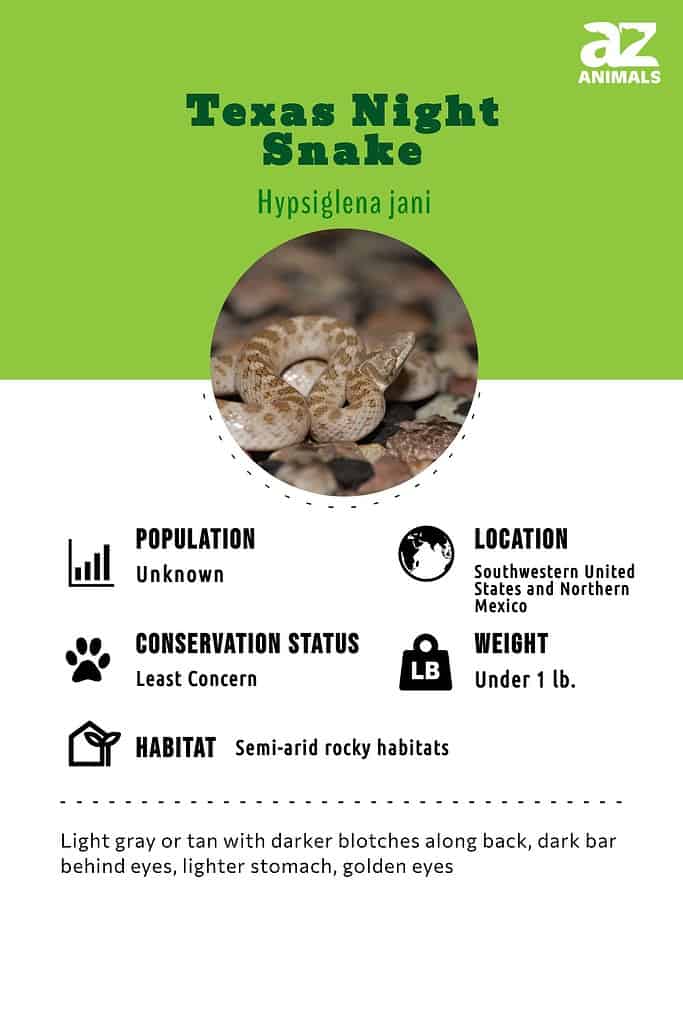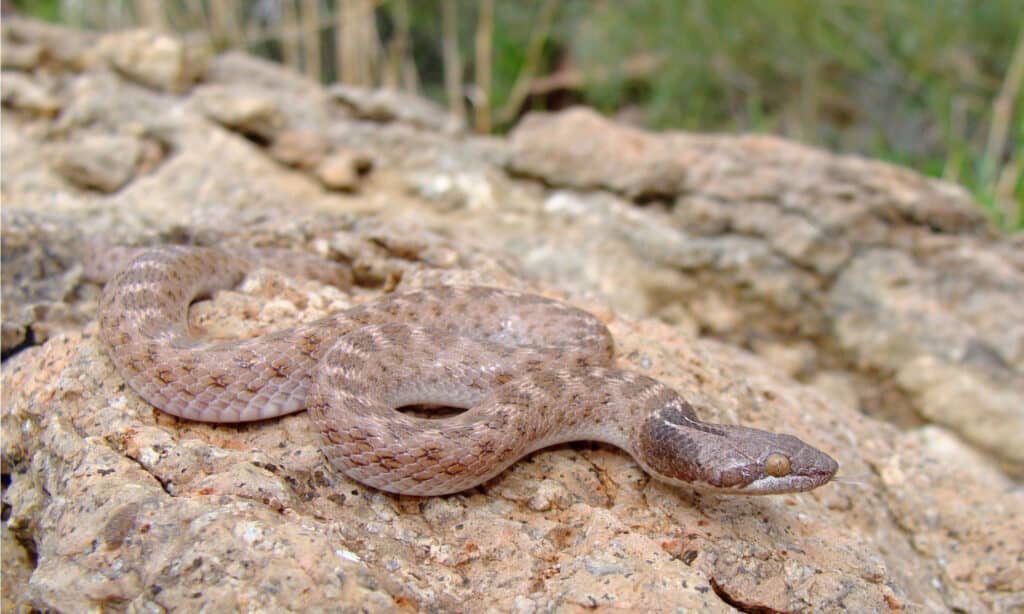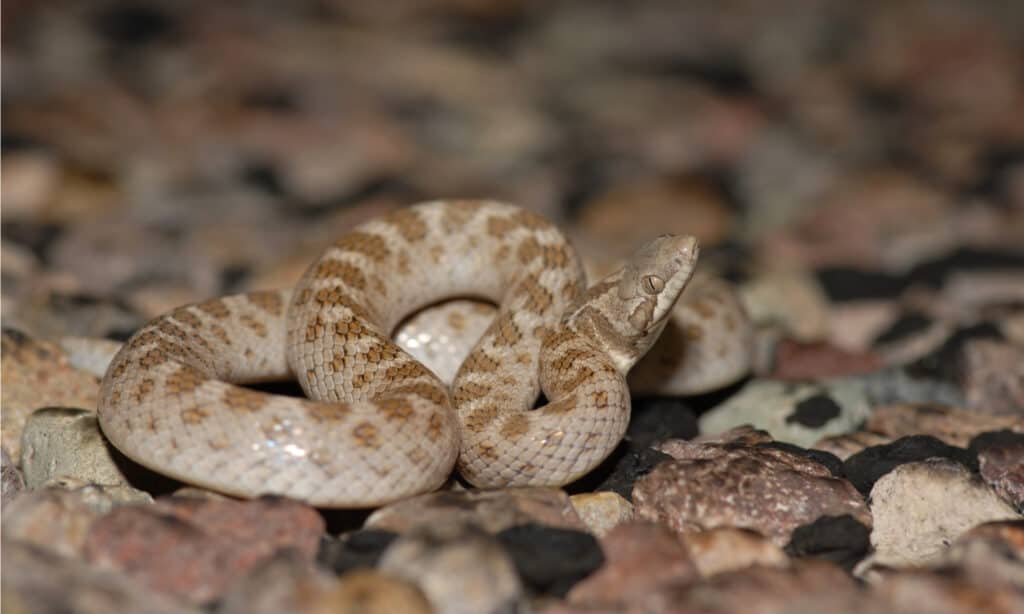Texas Night Snake
Hypsiglena jani
The Texas night snake has vertical pupils to help it see better at night.
Advertisement
Texas Night Snake Scientific Classification
- Kingdom
- Animalia
- Phylum
- Chordata
- Class
- Reptilia
- Order
- Squamata
- Family
- Colubridae
- Genus
- Hypsiglena
- Scientific Name
- Hypsiglena jani
Read our Complete Guide to Classification of Animals.
Texas Night Snake Conservation Status
Texas Night Snake Facts
- Main Prey
- Lizards, frogs, insects, and snakes
- Fun Fact
- The Texas night snake has vertical pupils to help it see better at night.
- Litter Size
- 4-6 eggs
View all of the Texas Night Snake images!
The Texas night snake has vertical pupils to help it see better at night.
The Texas night snake, also known just as often as the Chihuahuan night snake, spends most of the day hiding under rocks and logs. It comes out at night to hunt for its prey. This snake’s natural range maps across some of the driest areas of North America. It is often seen slithering around roads on warm nights during periods of heavy rainfall.
4 Texas Night Snake Amazing Facts
- The night snake’s reproductive season takes place every spring. After mating, the female lays a clutch of four to six eggs, which hatch during the summer. The juveniles are expected to begin immediately hunting for themselves without any help from their parents. The lifespan is not well-known, but it’s thought to be around 12 years.
- Vertical pupils are thought to have a few different purposes. They help to control the amount of light entering the eye throughout the day. They are also thought to help ambush predators like the night snake accurately gauge distance at night.
- Like many other types of snakes, the Texas night snake has an olfactory organ located on the roof of the mouth. After gathering chemicals from the air with its tongue, the snake presses the scent against the organ to smell.
- The Texas night snake may have once been considered a subspecies of the Sinaloa night snake (Hypsiglena torquata). However, after further investigation, it was elevated to its own species.

Where to Find Them
The Texas night snake is primarily found in semi-arid rocky habitats throughout the southwestern United States and northern Mexico, where it’s somewhat remote from most major population centers. It can be found in the following American states:
Scientific Name
The scientific name of the Texas night snake is Hypsiglena jani. The genus name comes from a combination of two Greek words: hypsi, meaning vertical, and gleno, meaning pupil. This obviously refers to the vertical-shaped pupil of the eye. The name jani was given in honor of the Italian taxonomist Giorgio Jan, who first described this species. They are closely related to desert night snakes, Sonoran night snakes, and similar species in the same genus. Three subspecies are currently recognized by taxonomists across its entire natural range map.

Texas Night Snake has vertical pupils that allow it to see in the dark when it’s hunting.
©Matt Jeppson/Shutterstock.com
History and Evolution
This snake evolved to thrive during the arid nights of Mexico and the American Southwest. The Texas Night Snake could not be more aptly named because its pupils have adapted to help this reptile see very well in remote darkness. Being vertical, the pupils reduce blur and help this snake judge the distance between it and whatever it is hunting or attempting to avoid. This is an example of eye structure evolution with additional muscles in the snakes’ eyes that provide increased contraction and dilation due to additional muscles. This gives it a great tactical advantage when they are looking for their next meal!
Because they hunt mostly small prey, such as lizards, frogs, insects, and snakes, their venom is weak and appropriate for getting the job done for those unfortunate victims. If this snake runs across anything larger than those, it relies on its own small size and excellent camouflage. The Texas Night Snake’s brown and patterned skin helps it blend in with its rocky, sandy surrounding. Because its working hours are in the dark, it also is able to avoid any unwanted interactions with most would-be predators.
Population & Conservation Status
According to the IUCN Red List, the Texas night snake is a species of least concern. It does not face any serious threats in its natural habitat. Population numbers have never been properly estimated, but they appear to be stable and fairly common.
How to Identify the Them: Appearance and Description
The Texas night snake is a small species, measuring approximately 10 to 16 inches long and rarely exceeding 24 inches. The body is light gray or tan with darker blotches spaced regularly along the back and a dark bar that runs behind each eye. It also has a whiter stomach and gold-colored eyes. This rather ordinary-looking color scheme provides camouflage against the ground so it can blend in and evade dangerous predators. The vertical pupils allow it to see in the dark when it’s hunting. The rear fangs are positioned in the back of the mouth and help subdue prey.
Here is how to identify the Texas night snake:
- Short, thin body measuring up to 24 inches long
- Light gray or tan body with darker blotches along the back
- Dark bar behind each eye
- White stomach
- Smooth scales
- Gold-colored eyes with vertical pupils
- The minimal distinction between head and neck

©Matt Jeppson/Shutterstock.com
How Dangerous Are They?
Although the Texas night snake is capable of producing venom, it is not dangerous to people at all. At worst, the bite victim might experience mild symptoms such as pain, swelling, and bleeding. No serious complications are known to occur from the venom itself. If you are bitten, you should wash and clean the wound as soon as possible to prevent an infection. It might be a good idea to seek some medical attention, especially if you think you might be experiencing an allergic reaction. For the most part, however, there is very little to worry about. Because the fangs are positioned in the back of the mouth, they may have trouble biting a human.

A Texas night snake measures approximately 10 to 16 inches long and rarely exceeds 24 inches and is not dangerous to humans.
©Rusty Dodson/Shutterstock.com
Behavior and Humans
The Texas night snake is fairly docile and timid around humans. They would rather try to run away and hide under the nearest rock or log than stand their ground and fight. These snakes will only bite people if they feel cornered and threatened. Despite how common they are in the wild, the Texas night snake is generally not a popular pet. Their small size, ordinary colors, nocturnal lifestyle, and preference for wild lizards and frogs mean they’re not as interesting to keep as a pet compared with some other species of snakes. Fortunately, if you ever happen to tame one, they are fairly easy to handle and not very aggressive at all. They also have a decent lifespan. Just don’t expect any pet stores to sell them directly.
View all 133 animals that start with TTexas Night Snake FAQs (Frequently Asked Questions)
Are Texas night snakes venomous?
Yes, the Texas night snake does have the ability to produce mild venom. Fortunately, even if you are bitten, it should have very minimal effects on humans.
How do Texas night snakes hunt?
These nocturnal species come out at night to hunt for prey by using their well-developed sense of smell. Once they’ve located their quarry, the Texas night snake will try to grasp the prey in its mouth and inject the venom with its fangs to subdue it. The snake will then try to swallow its prey whole.
Are Texas night snakes aggressive?
Unless cornered, they are not considered to be aggressive toward people at all.
Where do Texas night snakes live?
The range map of the Texas night snake stretches across dry, rocky habitats of the southwestern United States and northern Mexico.
What do Texas night snakes eat?
The Texas night snake feeds almost exclusively on lizards and frogs. It will also sometimes eat soft-bodied insects and smaller snakes. This diet is difficult to replicate in captivity; it may refuse food you buy from the pet store.
What does a Texas night snake look like?
The Texas night snake is characterized by a very thin light gray or brown body with darker blotches along the back, vertical pupils, a white stomach, and a dark bar around the eyes. Most specimens measure somewhere between 10 and 16 inches long.
Thank you for reading! Have some feedback for us? Contact the AZ Animals editorial team.
Sources
- OK Snakes, Available here: http://www.oksnakes.org/texas-nightsnake.html
- Reptiles Magazine, Available here: https://reptilesmagazine.com/night-snake-information/
- Berkeley News, Available here: https://news.berkeley.edu/2015/08/07/pupil-shape-and-ecological-niche/

















